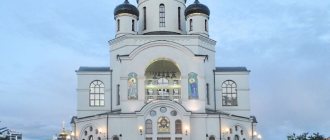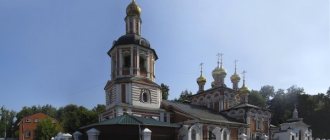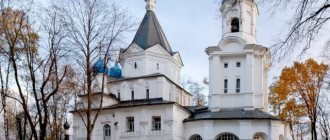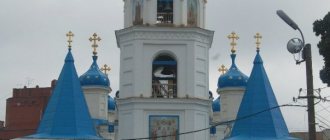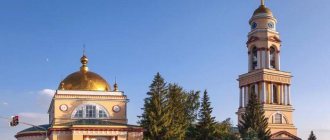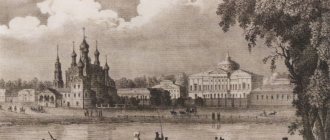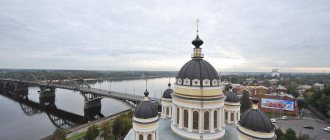| The map is loading... {"markers":[{"pos":[{"lat":59.20732858232867812375843641348183155059814453125,"lon":39.8749189052213708350791421253234148025512 6953125}]}],,"center":{"lat":{"lat":59.20732858232867812375843641348183155059814453125,"lon":39.87491890522137083507914212532341480255126953125 } ,"tileLayer":"//{s}.tile.openstreetmap.org/{z}/{x}/{y}.png","attribution":"\u0026copy; \u003Ca href=\"https://osm.org/copyright\"\u003EOpenStreetMap\u003C/a\u003E contributors","zoom":"17″} | |
| name of the property | Church of the Nativity of the Blessed Virgin Mary |
Church of the Nativity of the Blessed Virgin Mary
, Nativity of the Virgin Mary Cathedral, cemetery Church of the Nativity of the Virgin Mary, Nativity of the Virgin Mary Church, church behind the Gorbaty Bridge
The temple is located on the territory of the former Bogorodskoye cemetery near the railway and the Gorbaty Bridge - an overpass connecting the square in front of the station with the Poshekhonskoe highway.
Until the end of the 18th century, all Vologda parish churches had their own small cemeteries. After a series of pestilence epidemics, by decree of Catherine the Great, land plots on the outskirts were allocated in the cities of the Russian Empire for the organization of cemeteries. The first such cemetery was formed in 1781 not far from the current Church of St. Nicholas on Glinki. In 1782, land surveyor Neelov indicated the location of the Bogorodskoye cemetery:
| “Located... opposite the old cemetery of the Church of St. Nicholas the Wonderworker, which is on Glinki, from the last line of the rampart, three hundred fathoms.” |
Initially, funeral services were held in the Glinkovsky Church, which is why the cemetery was called Glinkovsky (The name “Zaglinkovsky Nikolaevsky” is also found).
However, the Glinka cemetery did not last long. Due to the proximity of the churchyard to residential buildings, the city authorities decided to found a new cemetery, which received the name Bogorodskoye from the cemetery Church of the Nativity of the Virgin. In the 19th century it became the main one in the city. During the First World War, a special plot was allocated at the Bogorodskoye cemetery for the burial of soldiers who fell on the battlefields or died from wounds in Vologda hospitals. The cemetery was closed in 1937, although burials there (including those of Leningrad siege survivors) were carried out during the Great Patriotic War.
The first stone small Church of the Virgin Mary on the territory of the cemetery was built, presumably, in 1780–1790, but already in 1819 the temple fell into disrepair. There was a need for its radical restructuring.
The current Nativity of the Virgin Cathedral was built in the 1830s on the initiative of church warden A.I. Popova-Testov with funds donated by parishioners.
Cathedral of the Nativity of the Blessed Virgin Mary today
The temple building was erected in honor of the birth of the Mother of God, which is why it got its name. It has the status of a functioning Cathedral.
Services are conducted in Church Slavonic. The building was built to strengthen Orthodoxy on Vologda land and today is its stronghold in this region. The cathedral is visited annually by thousands of believers in the Vologda region and surrounding regions of Russia.
The parish of the temple is located on Govorovsky Ave., building 2A.
History of foundation, construction
In the second half of the 18th century. In Vologda, by order of Catherine II, in order to combat epidemics, a new separate cemetery was created outside the city limits, which was called Bogorodskoye. Soon a stone church was built near the cemetery. The city's population was constantly growing and soon the building was insufficient to accommodate all the parishioners.
In 1832, city mayor A.I. Popov-Testov was asked to lay a new building for the cathedral, which would be more spacious and capacious. It is this that has survived to this day. In 1836, construction was completed and the building was illuminated. In the beginning. In the 20th century, thanks to the efforts of the city warden of the church, Nikolai Kubryakov, the cathedral building underwent some changes - the entrance to the 2nd floor was redone and the refectory was extended.
Cathedral of the Nativity of the Virgin Mary in Vologda. Photo from the late 19th century
The Bolshevik victory had a strong impact on all the religious buildings of the former empire. The Cathedral of the Nativity of the Blessed Virgin Mary was no exception - items of church utensils of even slight value were subject to confiscation in favor of the Soviet state. During the Volga famine, local clergy provided all possible assistance to those in need, sharing food and things with them.
By 1927, after the second floor was closed, a renovation community was created in the church, where 7 priests served. It united parishioners from all over the area. As part of the fight against the ministers of the Christian Church and religion, by 1937 the Bogoroditskoye cemetery was completely closed, and the clergy were detained by NKVD officers.
By the 40s, the cathedral remained the only functioning temple in the Vologda region. As the Nazis moved deeper into the territory of the USSR, more and more people began to come to him for repentance and prayers, for hope and faith in victory. This became the reason for the opening of the second floor of the temple and the restoration of its work. However, after the end of the war with Germany, the cathedral was closed again.
After the collapse of the USSR, the attitude of the State towards the Church changed sharply, a “thaw” came and the Russian Orthodox Church began to actively restore the building.
Heirs of the New Martyrs
– I often think that today we fall far short of the Church, which was almost destroyed by Bolshevik persecution, but nevertheless survived thanks to the feat of the new martyrs. Does this mean that periods of ups and downs are inevitable in the life of the Church?
– I think so, yes, the entire history of the Church can be represented as a series of persecutions or oppressions of an external and internal nature. As soon as the Church recovered from any new misfortune, a new one immediately arose. If we evaluate the current situation from this point of view, we can say that the time of external persecution has passed, the Church is beginning (just beginning!) to restore strength, and if external persecution does not seem to be expected in the near future, then issues of the internal health of the Church become relevant.
For the Church, as they say, to come to its senses after seventy years of persecution, it takes a lot, a lot of time. Now from different camps – both “pro-church” and “extra-church” – they are making demands on what they would like the Church to be like: it must be active, participate in this, take care of this. These demands are placed on the Church as a full-fledged component of our society, but one must understand that the Russian Orthodox Church, if we regard it as an organization, is now far from being the powerful force that it appeared, say, before the revolution. The modern Church can be compared to a person who has had every single bone broken and who is just coming to his senses, just getting back on his feet. What can you demand from him? Today the Church cannot adequately restore even its liturgical life, let alone external activity. Let's simply compare the number of churches, say, in Vologda before and after the era of persecution. What will we see? The difference is colossal! Now there are a catastrophic shortage of churches in the city.
– I read that at the end of the 19th century the number of parishioners of this temple was only 180 people...
– Yes, and it was a completely acceptable figure. How many churches should there be for the 300 thousand population of Vologda today?! I'll tell you how much, forgive me for going deeper into statistics. In 1913, in Vologda there were about fifty churches for a population of 30 thousand. This means that for the current population in the city, this figure should be increased tenfold! Five hundred churches in Vologda is a figure that describes the normal ratio, but we have about twenty. This is twenty-five times less! I don’t think that Vologda is an exception in this regard; it probably more or less reflects the general Russian picture. We judge the Church from the point of view of its one hundred percent power, which it possessed more than a hundred years ago, but today has recovered only four percent. What kind of requirements can you make of her?! And if the Church is still active, and so much so that it is capable of causing discontent among its ill-wishers, then this is a miracle! Its activity is simply unprecedented in all previous history. I think it is impossible to find any period of time in the history of the Church with which one could not only compare, but at least correlate the surge of activity that we have observed in the activities of the Church over the past 20-25 years.
Chapel of the Great Martyr Anastasia the Pattern Maker in the village of Chashnikovo
– In 2007, you participated in the construction of a chapel in the name of the Great Martyr Anastasia the Pattern Maker in the village of Chashnikovo on the outskirts of Vologda, where mass executions took place in the thirties...
– In 1938, nun Anastasia, the grandmother of nun Sergius (Khvostova) from the Intercession Monastery in the town of Bussy-en-Haute (France), was shot here. Mother Sergius searched for Anastasia’s resting place for a long time, and this search led her to Vologda. She donated her personal funds to the chapel at the site of the executions and asked me to take care of its construction.
– Is this because you had to deal with the topic of repression?
– No, I had to deal with wooden construction.
– And what were your first impressions?
– These are the feelings experienced by any person who encounters history in real life. I myself took a little part in the installation of this chapel - I came across human bones at the level of a spade bayonet. There is a lot that we read about in books, but when reading, detachment remains. When you are in direct contact, it is a different way of perceiving reality, the impersonal becomes personal.
– There is such a point of view that martyrdom is something that goes back to the Roman Colosseum, wild beasts tearing apart the early Christians. And most of our compatriots are rather sufferers. They went to prison and to execution, often not realizing their path was precisely the path to Calvary for the sake of Christ.
– I wouldn’t get attached to the terms here – I don’t see any fundamental difference. In church tradition, martyrs are also called passion-bearers, and vice versa. The fact that our persecution was outwardly arranged differently from the Roman Empire—we had a different situation, a different era, a different country, a different legal field. And even though many of the new martyrs were not offered the opportunity to save their lives by renouncing the faith, they still made their choice - not at the moment of suffering, but before they decided to remain Christians under the atheistic government. The cause of suffering and death was precisely their faith.
– According to my feelings, in our society, just like a hundred years ago, the veneration of saints is higher than the veneration of martyrs. But it is the relics of the martyrs that are at the base of our churches...
– I sincerely believe that time puts everything in its place. This is especially true for the Church. As the new martyrs become better known, they will be prayed to more often, miracles will accordingly occur more often, and over time their veneration will only grow. In any case, the trend of growing veneration is already noticeable: the names of some new martyrs in calendars are already marked in red instead of black, and, for example, Bishop Hilarion (Trinity) - he died in prison - is already being referred to as one of the holy fathers.
Architect, exterior decoration, architectural ensemble
The Cathedral of the Nativity of the Virgin Mary in Vologda stands out among other city-wide buildings. It is believed that the building was built in the classicist style with Empire elements.
The following features indicate this:
- The longitudinal shape of the building with a clearly defined central axis of symmetry.
- The side facade has double doors with unique decoration.
- The main facade of the building is divided by cornices made in a horizontal form in the form of belts.
- At the top of the brick rotunda is a dome.
- In the center of the cross, a bell tower was erected, covered with ribbon rustication.
- 8 arched ceilings in the belfry.
The walls of the building reach a thickness of 105 cm, the basement basement is equipped with vents for ventilation of the room. The building has separate entrances on the ground floor and a staircase leading directly to the second floor.
The external decoration of the first floor has retained many elements of antiquity. The entrance door of the first floor is reinforced with a wrought-iron lattice from the 19th century, the window openings are decorated with stones, the altar is separated by three arched passages, the building is heated by tiled stoves, and the connection between the ceiling and walls is decorated with stucco.
In the 20th century The building was redecorated - the facades were painted in pastel colors, the paintings were updated, and galvanized iron was laid on the roof.
On the market
The Church of the Nativity of the Virgin Mary on Nizhny Dol is being restored
– I can imagine the parish as a kind of small state. There is both a “king” and a clergyman – conventionally, these are “boyars”. And “ten” is a kind of “thought”... In this microcosm, did you manage to change everything the way you wanted? Or was it like this: you hit your forehead, but it doesn’t work? And you leave it to God’s will...
– Well, firstly, before me, the rectors of the Church of the Intercession at Torg were far from the worst priests; the traditions remained alive after the death of the first rector. Therefore, I did not have to feel like a transformative fighter.
– I’m not saying that when a river flows, it should be stopped, but should the river bed be corrected?..
– I think in some other categories. To change means that it was bad before me, but I will do it well. This parish was dear to me - I was baptized there. And I decided to try for him. Having become a rector, I felt that the situation demanded that something be done. The first is to reduce the volume of resource consumption, the second is to establish their replenishment. For a certain time, the parish lived by maintaining its existence. But, roughly speaking, the last supplies will run out. So, what is next? I looked: everything was slowly deteriorating. I cut bonuses, tightened the screws, reduced the staff a little... Well, in terms of acquisitions, there was greater openness of the media, publishing activities and all sorts of actions that had a public resonance. For example, “Honey Fair”, “Molodezhka”, Sunday school... There were three or four notable events regarding the bringing of relics. As a general diocesan event, this required great organizational efforts. One of them was very noticeable - with the relics of Matrona of Moscow, which directly shocked Vologda society. We didn't expect such a response. As they say, they hit the vein. Now no matter how much you bring relics, there is no such thing. You need to know our former ruler to understand how difficult it was to do this. Since he demanded the complete study of any matter, questions often came to his mind that were difficult to foresee. He looks: these are the planned expenses. Are electricity costs included in this? How come you didn’t think about this! Is the salary indicated with or without taxes?..
– Probably, after such active, hectic activity, to be rector of a dilapidated church is a strong contrast, such a cold shower?
– Well, I’m not a fan of heartbreaking comparisons. At my previous parish - by the way, where I am still listed as a clergyman to this day - I was in a hurry, knowing that this kind of position does not last long. The experience of previous abbots only confirmed this. In general, being a rector was rarely perceived as a blessing in our diocese. I got used to the idea of inevitable removal from the parish a long time ago; this process was started by the previous bishop. I waited a year and a half for this to happen. Once I wasn’t even the rector for two hours when the bishop said: “That’s it, you’re not the rector!” Then, however, he called: “The last warning for you, they asked and begged me to leave you…”
- Was there any resentment?
– After the dismissal, the moment of personal resentment was not clearly expressed. Maybe because something else turned out to be more important... I didn’t go into emptiness - I was entrusted with the restoration of the Nizhny Dolsk temple. When I first visited this temple, having received the order, the walls looked even more bare than they do now. But here I suddenly felt an inexplicable and irresistible feeling of something familiar, some kind of comfort. Lawless Heart. The sensations and my own reactions were unexpected for me...
Interior decoration
The classic interior content of the temple consists of walls and temple icons painted on church themes. The interior doors have been preserved since the construction of the temple.
They have applied copper flowers and 3D diamond details as decoration. The walls are painted in soft shades of green and yellow, and the lighting is electric. There is an iconostasis made in the form of a wooden structure with niches and shelves.
Social work, everyday life
The clergy of the cathedral keep up with the times and spread the word of God not only through services within the walls of the temple and communication with people outside of it. Work in this direction is also being carried out on the Internet.
For example, the cathedral has its own group on VKontakte, where speeches of famous people on religious topics, congratulations on holidays, as well as information for believers are constantly published.
The activities of the church rector and the successes of Sunday school students are often written about in local print and Internet publications. Also, the rector of the cathedral periodically organizes pilgrimage trips to various localities in Russia to visit historical places and shrines.
There is a Social Assistance Center at the cathedral, open seven days a week from 10 a.m. to 2 p.m. Anyone can take part in its activities.
Don't miss the most popular article in the section: Metro Nizhny Novgorod. Diagram, map, description.
Prison Ministry
– As a rector, you not only serve in the parish, but for 15 years now you have been taking care of the local women’s correctional colony. On its territory there was even a temple built in honor of the icon of the Mother of God “Joy of All Who Sorrow.” This means you have something to compare with: now and before, in the wild and in the zone. Is there any fundamental difference in the structure of church life in the colony and outside it?
– I don’t see much difference. Both on one side and on the other side of the barbed wire, the Church appears as a place where a repentant sinner seeks salvation. The confession of a person in prison is not fundamentally different from the confession of a person at large. The same sins, but the difference is perhaps one offense, for which the convicted person pays. In general, prison, in my opinion, is not so much a special world as a cross-section of our society as a whole; changes in society can be traced in miniature in prison. In particular, people’s attitude towards the Church: with the churching of society, Orthodox people, baptized people, and Sunday school students began to appear in places of detention...
- Therefore, those who know about the Orthodox commandments are in greater demand...
– I am sure that the majority knows about the commandments, at least some of them, but a conscious decision to straighten their lives according to them is made by a minority. But this is a separate topic. But in general, we can talk about a growing interest in Orthodoxy, which is reflected in places of imprisonment. In the colony where I serve, I asked to collect information about those reading Orthodox literature in the library. Because not everyone goes to church, but quietly, in the pillow, as they say, many people believe and pray. When a person goes to church, this is already such an external positioning of oneself, this entails a change in the attitude of others, and its own difficulties arise... So, the number of both readers and literature read is growing. Over the past years, at least two thirds of convicted women have been interested in Orthodox literature. These studies make me an optimist.
– Is that why the cult of power in places of detention is going away?
– It was not particularly developed in women’s colonies. In men's colonies, the community of convicts is hierarchical: everyone takes their place, and it is maintained by force, and often created by force. In women's colonies it is softer, but also more difficult: there are no castes here. There is no one who looks after everyone. A woman in the criminal world is not a “subject of law.” Here the world is structured around the individual, everything depends on his character and inclinations. Therefore, instead of a single hierarchy, several pockets of completely autonomous communities are possible.
– Does the presence of any kind of church life in places of detention give hope that people will leave there at least no worse off than when they got there? Or will prison always hurt people?
– Let’s remember Solzhenitsyn. According to him, he owed the good things that happened in life to prison. I think this is true, just as it is true that bad communities corrupt good morals. So a lot depends on the position of the person who ends up in prison. But in general there is a direct relationship between the presence of the Church in places of deprivation of liberty and the correction of convicts. This is also noted by employees of the Federal Penitentiary Service, who are aware of the statistics: a decrease in the number of malicious crimes depends on the appearance of churches in places of deprivation of liberty.
– Do you feel the same?
- Yes. The presence of the Church in places of deprivation of liberty is, in principle, a burden for the administration; it requires additional efforts and organizational efforts. Despite this, the administration always gives positive feedback on any church initiative. This means there is a practical benefit. After the communist ideology collapsed in our country, Orthodoxy was the only thing that was at hand. It is not with market values that you will teach convicts to obey the laws.
Even purely psychologically: here is a man standing in line for verification. Does it make a difference what is in front of him: a temple or a gray wall? Of course have. Among the convicts who strived for church life in the colony, with whom I manage to maintain contact after release, of those fifty people - those whom I remember and commemorate - only three or four returned to places of imprisonment. This recidivism rate is ten times lower than the general prison rate.
Sunday School
The Cathedral of the Nativity of the Virgin Mary in Vologda has its own parish Sunday school, where primary school children go. Her head teacher is Elena Borisovna Shlykova, and the head of the youth service is Priest Konstantin (Volkov).
In addition to the general education program, students receive the necessary knowledge about religion and service in the Church, get acquainted with the Bible and the lives of many saints. The school also has a special class for former graduates, where children from 12 to 16 years old continue their education. Classes are held on weekends from 10 a.m.
Church of the Presentation of the Lord
Church of the Presentation of the Lord is an active Orthodox church, address: VI Army Embankment, 85.
The Church of the Presentation of the Lord on the Embankment was built in 1731 - 1735. Previously, there was a wooden church on this site, built no later than 1656.
The elongated cube is decorated with a wide cornice and five domes on thin drums. The architectural design of the church successfully merged traditional Russian patterns of the 17th century and Russian Baroque, which came to Vologda late. The facade of the Sretenskaya Church is decorated with green tiles depicting stems, branches and flowers - a unique detail for Vologda churches of that time. The through, light upper tier of the bell tower in the pseudo-Gothic style was built on later - in the 1830s. The bell tower ends with a tall, sharp spire.
Opening hours for visitors
The cathedral's operating hours and schedule of services are presented in the table below.
| Day of the week | Operating mode | Divine service | Time |
| Mon | 7:00 – 19:00 | Liturgy | 8:00 |
| Tue | Liturgy | 8:00 | |
| Akathist before the icon “Inexhaustible Chalice” | 17:00 | ||
| Wed | Liturgy | 8:00 | |
| Akathists to St. Nicholas, Rev. Joseph of Spasokubensky, St. right Nikolai Vologda | 17:00 | ||
| Thu | Liturgy | 8:00 | |
| Akathist before the icon “Quick to Hear” | 10:00 | ||
| Fri | Liturgy | 8:00 | |
| Sat | Liturgy | 7:00 | |
| 9:00 | |||
| Sun | Liturgy | 7:00 | |
| 9:00 | |||
| Akathist to the Savior | 17:00 |
Interesting facts about the cathedral
In the 20th century The department of Vologda bishops operated on the territory of the cathedral. In 1947, for the 800th anniversary of the city, it was planned to convert the cathedral into a museum, then into a club or an art gallery. However, under pressure from the population this was avoided.
On August 18, 1992, the cathedral was visited by Patriarch of Moscow and All Rus' Alexy II. During the visit, the bishop noted the successes of the local rector in restoring the cathedral, after which the Divine Liturgy was celebrated.
Where is it located, what is in the surrounding area, how to get there
Once in Vologda, getting to the cathedral is easy and simple, because it is located in the city center. There are 2 stops close to it - “Hotel Vologda” and “Gorbaty Bridge”. The first one is served by buses No. 1, 28, 144, as well as minibuses 7, 11/13, 14, 23, 29, 30, 35 and trolleybus No. 4, and the second one is served by minibus No. 20. From both stops, the cathedral building is within walking distance and visible distance.
The central and railway stations of Vologda are also located at a distance of 550 m from the cathedral. In order to get to the temple, you need to leave the station building, walk through Babushkin Square and then turn left, exiting onto Poshekhonskoye Highway. After passing the Gorbaty Bridge, on the right there will be the Bogoroditskoe cemetery, on the territory of which the cathedral will stand.
Not far from the Cathedral of the Nativity of the Blessed Virgin Mary there are several buildings of government institutions, as well as two more religious buildings - in the park near Govorovsky Prospect there is the Chapel of St. Nicholas of Vologda, and on the other side of the Gorbaty Bridge there is the Protestant Church "Potter's House".
Information for pilgrims
On the territory of the Cathedral there is a Church Shop, where you can buy consecrated oil, icons with images of saints, crucifixes and candles, religious literature, as well as textile products (shawls, stoles, scarves). The rector of the cathedral consecrates homespun icons made by parishioners.
There is no opportunity for pilgrims to stay overnight within the walls of the cathedral, however, at 2B Govorovsky Ave there is the Favor hostel, where a bed costs 800 rubles per day. It is located 350 m from the Bogoroditsky cemetery.
If you cross the Gorbaty Bridge, then on the street. Puteynaya, 14 you can find the Sputnik Hotel, offering from 1520 rubles/day. rooms for their guests. On the street Mira, 92, 200 meters from Sputnik, there is another hotel - Vologda.
The cost of rooms in this hotel starts from 3150 rubles. for daily rent of a standard room. For pilgrims leaving Vologda early in the morning, an alternative option would be to spend the night in the “24x7” hostel, which is located near the Vologda-1 railway station at the address: Tekhnikumovsky lane, 2. The cost of a bed for one day here is 1,300 rubles.
In general, there are quite a lot of places in Vologda where you can spend the night if you have to stay overnight after visiting the Cathedral of the Nativity of the Blessed Virgin Mary. Its convenient location in the very center of the city makes the cathedral a particularly popular place among Christians in northern Russia.
Author: Mikhail Pushkarev
Article design: Vladimir the Great
Everything has its time
– Is there another sphere of public life where the presence of the Church is necessary?
- Education. This is traditionally an area that the Church has paid attention to. After all, initially education was generally church-based.
– Let’s assume that some legislation comes out that allows priests to go to schools and directly address teachers and students. Do you have anything to say to the priest and the Church as a whole?
– They always have something to say, another thing is that with God everything happens in due time, especially for those who know how to wait. Just because the Church is absent in this area does not mean that it is necessary to break through there. I am a supporter of the evolutionary approach. This will be realized when the Church matures. When she gets on her feet enough to be able to forge her own cadres who can do this.
– They often say: while you are sleeping there, we are losing another generation.
“You can’t say it better than the holy fathers: don’t try to stop world processes with your weak hand; pay attention to yourself. It’s the same here: we talk about Russia, but we spoil our neighbor. May the Lord take care of Russia. But if you think a little, then examples of this kind of seemingly natural changes are already visible. For example, the very appearance of the concept of “moral values” - 20 years ago there was no trace of this, but now it is at every step. Remember the evolution of the concept of “patriotism” from abusive to positive – it seemed to happen spontaneously before our eyes. Such things indicate that the hat has become “Senka’s way” - that is, some changes have occurred in Senka.
– Often action is equal to reaction... How angry is the blogosphere now with the Church: “The priests are interfering with our children!” There is a feeling that what we already went through at the beginning of the twentieth century is being repeated...
- I think it's natural. Well, how could it be otherwise? In my opinion, we are now slowly building a system - a program for saving Russia; not everyone is happy with this. Because what is it like with us now? Pull one person out and everything will fall apart. In our country, a lot rests on personal charisma, and not on the system. For Russia, unlike other countries, this is typical.
- This is bad?
- Hard to say. The act of Vladimir the Great - the choice of faith for the people - was the step of one person. And what are the consequences! And Peter the Great! He also personally broke everything, redoing it in a new way...
